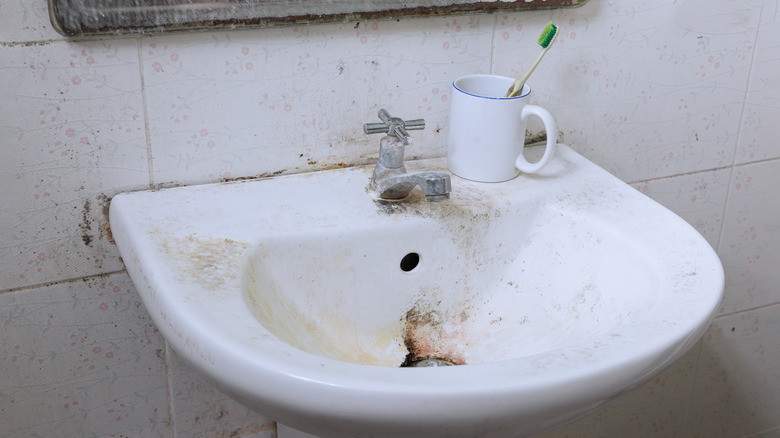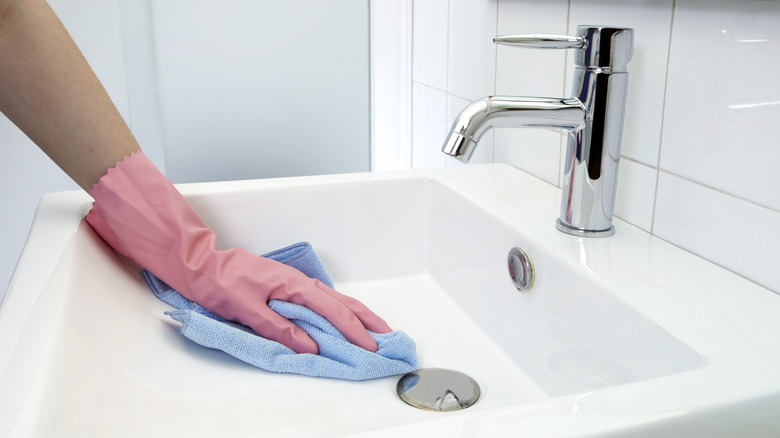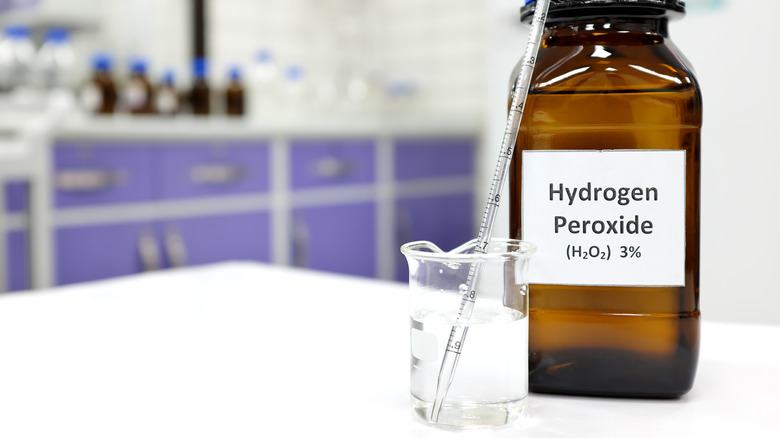Reach For This Household Essential To Remove Mold From Your Sink
One of the most troubling things you can find growing around your sink is mold. It develops here due to moisture and organic matter, which create ideal conditions for mold growth. Sinks are frequently exposed to water from activities like washing dishes or our hands, providing the moisture necessary for mold to thrive. Additionally, food particles, soap scum, and other organic debris can accumulate in and around the sink, serving as a food source. Poor ventilation in bathrooms or kitchens can exacerbate the problem by trapping moisture in the air. These factors create a conducive environment for mold spores to settle and proliferate, leading to the development of mold colonies around the sink area. Fortunately, a bottle of hydrogen peroxide can save your moldy sink and restore a healthy environment in your home.
Hydrogen peroxide is an excellent resource for removing mold from your sink due to its potent antimicrobial properties and versatility. It effectively kills mold spores on contact, breaking down the mold's structure and inhibiting its growth. Unlike harsh chemical cleaners, hydrogen peroxide is relatively safe for household use and environmentally friendly, as it decomposes into water and oxygen. Its mild bleaching action helps to lighten stains left by mold without causing damage to most surfaces. Additionally, hydrogen peroxide is readily available at most stores and affordable, making it a convenient choice for mold removal. Overall, its effectiveness, safety, and accessibility make hydrogen peroxide a great option for tackling mold around your sink.
How to use hydrogen peroxide to remove mold
To effectively use hydrogen peroxide to clean mold from your sink, you'll need to follow a systematic approach. Begin by ensuring the sink area is well-ventilated to prevent inhaling fumes. Open windows or use a fan if possible. Next, use gloves and safety goggles to protect your skin and eyes from potential irritation. Start by mixing equal parts hydrogen peroxide and water in a spray bottle. A concentration of 3% hydrogen peroxide is typically safe for household use. Shake the bottle well to ensure the solution is thoroughly mixed. Then, spray the affected areas of the sink generously with the hydrogen peroxide solution. Ensure that the moldy areas are completely saturated.
Allow the solution to sit on the moldy surfaces for about 10 to 15 minutes. While waiting, you may notice some foaming or bubbling, which indicates that the hydrogen peroxide is actively reacting with the mold. After the dwell time has passed, use a scrub brush or sponge to gently scrub the moldy areas of the sink. The mold should loosen and come off relatively easily. Rinse the sink thoroughly with water to remove any remaining hydrogen peroxide solution and mold residue. Finally, dry the sink with a clean cloth or paper towel. Dispose of any used cleaning materials properly and wash your hands thoroughly after completing the process. Follow these steps, and you can effectively use hydrogen peroxide to remove mold from your sink and restore its cleanliness and hygiene.
Cautions for using hydrogen peroxide
While hydrogen peroxide can be effective in removing mold from sinks, it's important to be aware of certain cautions and potential dangers associated with its use. Hydrogen peroxide is a mild bleach. It can cause discoloration or damage certain materials, especially delicate surfaces like marble or granite. Before using hydrogen peroxide, it's advisable to test it on a small, inconspicuous area of the sink to ensure it doesn't cause any adverse effects or inadvertently bleach your countertops.
Another caution is to avoid mixing hydrogen peroxide with other cleaning agents, particularly those containing ammonia or vinegar. Combining hydrogen peroxide with these substances can produce harmful gases, like chlorine gas, which are extremely hazardous to health if inhaled. Additionally, gases such as these can also become extremely hot or cause a deadly explosion. For these reasons, it's essential to always use hydrogen peroxide on its own or in combination with water as directed. The same can be said for any bleach or ammonia-based chemical cleaners.
Lastly, store hydrogen peroxide securely in a cool, dark place away from curious children and pets. Exposure to light and heat can cause hydrogen peroxide to degrade more rapidly, reducing its effectiveness. Always check the expiration date on the bottle and discard any expired or deteriorated hydrogen peroxide. By being mindful of these cautions and following proper safety procedures, you can use hydrogen peroxide effectively and safely to remove any mold growing from your sink.


